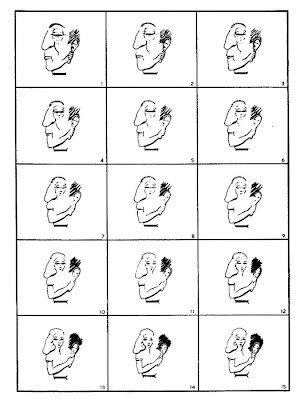Last week I had the pleasure of spending four days birding at Barrow, Alaska, working on an eider identification project with the US Fish and Wildlife Service. While there I was able to study hundreds of Greater White-fronted Geese that were grazing on the tundra – surprisingly numerous and surprisingly approachable. I’ll write a separate note about variation in the geese – size, bill color (pink to orange), and darkness of plumage all seemed to vary independently – but for today I want to comment on a psychological issue that I noticed while looking for these subtle variations.
A drawing showing a series of ambiguous figures is here:
Image from: Fisher, G. H. 1967. Measuring Ambiguity. American Journal of Psychology. 80:541-557.
This series shows an unambiguous “Old Gypsy woman” in the upper left, which then changes gradually to an unambiguous “Young woman with mirror” in the lower right. All of the intermediate drawings are more or less ambiguous: they could be interpreted either way (especially the ones in the center). Interestingly, starting at the corner allows your brain to “latch onto” one interpretation, and then that interpretation can be held across more than half of the series before it involuntarily switches. Once your perception switches, if you then scan back towards the starting point, some of those images will be perceived in the “new” way before involuntarily switching back.
After scanning many flocks of Greater White-fronted Geese at Barrow looking at bill color, I realized that I could perceive a single flock as mostly orange-billed on one scan, and mostly pink-billed on the next scan. Most of the geese have ambiguous bill colors (pinkish-orange or orangey-pink) and my perception was determined by which color I “latched onto” first. If I looked through the telescope and found an orange-billed bird (or called an ambiguous color “orange”), then scanning the rest of the flock would produce an impression that most or all were orange-billed. If I found an unambiguously pink-billed bird then my perception switched, and birds seen after that would be labeled “pinkish”.
I’ve long been aware that context has a profound influence on perception of these subtle and subjective features, but I have rarely experienced such a clear example of it. Birders often deal with these kinds of subtle judgments – size, shape, wingbeats, color, etc – and the stimuli are often ambiguous. We can jump to a conclusion about bird identification based on very limited information, and the jump can be guided by all kinds of subconscious and unrecognized factors. It’s valuable to be aware of these pitfalls, to understand the limits of perception and deduction, and to balance the tendency to jump to conclusions with a more thoughtful and cautious approach. A square peg, if it’s small enough, fits very nicely in a round hole.


This is a terrific post; I’d never connected these types of images with bird ID before. It makes perfect sense, particularly when looking at large flocks.
Terrific post…especially for all those grappling with waterfowl counts in the Southern parts of the world.